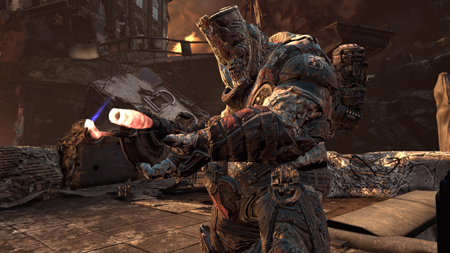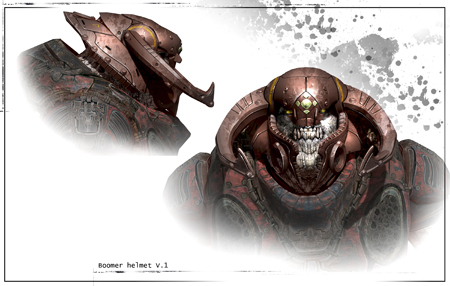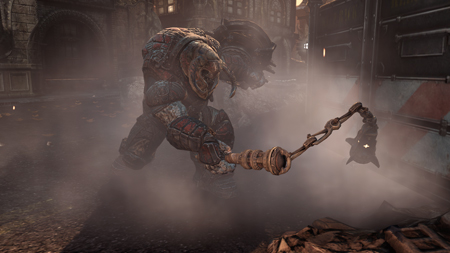Gears of War 2 Launch Party Interview
By Eli Green
November 7, 2008 - 16:30
While at the Gears of War 2 launch party last night, Lee Perry, Senior Gameplay Designer at Epic Games, took questions from various members of the mainstream and video game media. Perry spent the entire night brutalizing other gamers in multiplayer matches, all while being interviewed. I had the chance to speak to him about the process of creating the game and the work that goes into the general elements core gameplay design.
Eli Green: Your main role at Epic Games constitutes mostly the technical aspects of creating the game, correct?
Lee Perry: Yeah. Basically, I try to come up with the ideas for creatures, the weapons, different abilities for the player. Basically, I try to come up with the core game design decisions that make the game fun from minute to minute, as well as prototyping the stuff to making proof of concepts, pretty much trying to nail down what it is that makes the game fun, what we should be trying to improve, or cut, or trim, or add to the game to make it a better experience.
 |
Green: How do you go from building something like the original Gears and then move into something even more sophisticated ? How does the design advance so much?
Perry: Well, there's good and there's bad. With Gears 1 we made what we thought was fun, and we were hoping that people would think it was fun, but we didn't know. You send your baby out there, and you hope that people enjoy it while they're playing it. With Gears 2 you've got the benefit of you know what people like and what people don't like, and so you can selectively build on the strengths of your previous game. The problem that comes with that as well is that people have a lot more preferences now, about what they like and they don't like, so everything you tweak is potentially something that's going to upset somebody else, because they liked it the way it was or any number of gameplay decisions like that. And so, you really just have to balance the making it new and better without breaking what's there.
Green: They had actually mentioned in the developer diaries that “you killed this person off, how could you do that?”, but that was from a story aspect. Your perspective was really not so much changing how the characters were affected in what happens to them, but more in what they do.
Perry: Correct, exactly. My day to day work is not involved in the story, or dialogue or what people are saying. What I do is come up with the idea for a monster. What if we made a monster that's got this big explosive flail, and a shield that you can pick up and play? How do we make that control for the player? How do we make it fun? How do we balance it? And then kind of go into a prototyping stage, where I'll make a rough version and try to prove that it's fun and it's something we should try and do before we kick it over to artists and programmers to spend a lot more time polishing it up .
 |
| The concept art for the Mauler/Boomer |
Green: What's are these prototypes like compared to what we finally see? There's a lot more work involved once it's already essentially been approved, correct?
Perry: Yeah. There's a boatload of work. Most of it is, we'll take something, for example the Shield Boomer, which I mentioned before, the Mauler, which would basically be opening up a blank level, putting in an existing Boomer and then attaching different things to it, and then working with our scripting system, kind of doing a simplistic programmer pass on it to make it function. So they rarely would look like what you'll see in the final game, but we play them, we take a video and we can tell pretty quickly if it's something that's fun or compelling. It also lets us take advantage of the fact that we can iterate very quickly. So we'll make a new weapon, we'll see some problems with it initially, and then we can make changes to it really rapidly and turn around and try different versions of it.
Green: Are there any particular features that you would have wanted to get into Gears 2 that just couldn't have made it in?
Perry: Oh man! (laughing) I could be here for hours.
Green: Your favourite, that you were working so hard on, but you just couldn't squeeze it in.
Perry: You know, it's not even necessarily... A game to a designer is never done. You just ship it. Because if it were up to a designer working on our game, we would be a decade into it and still adding stuff.
Green: Duke Nukem Forever style.
Perry: There you go, yeah. But you can see how people fall into that trap, because it's not necessarily one feature, but everything that gets implemented, you want it to be better, or you want it to be more options, or you wish the character... you wish so and so monster had the ability to, y'know, do something else cooler. And so, across the board, you always want it to be more, more, more. But that's what's great, I mean, because there's sequels. There's always next time.
With that being said, I'm extremely happy with the leap between Gears 2 to (means from) Gears 1 because that's basically what this is. This is stuff we really wanted to do for Gears 1.
Green: So, from Gears 1, to Gears 2, to the future, do you see this technology still being viable for what you want to in your next games, or it will be, whatever's next is going to be the thing that really pushes your limit?
Perry: Well, we're always trying to push the limits of what the technology can do, because we constantly learn more and more. Every time we're doing something we're learning more about how to do it more efficiently, how to squeeze more into memory. Are we wasting too much space here or there? There's always room for improvement on it. And it's not like, the way the engine technology works, it's not like there's a hard day where you throw everything away and you make a new version. You're always building on your previous stuff, one incremental step at a time and so, just as Gears 2 looks better than Gears 1, you can still... there's still room for making the stuff look even better before the next generation of consoles come along. There's always room for improvement.
Green: We get a lot of questions from younger readers at our site about how to get into the industry. Do you have any particular tips of things they can do, from your side of things at the very least, on how to become somebody who will be ready for a job in the industry?
 |
| The Mauler/Boomer in its full form. |
Perry: Absolutely. One of the coolest things, by far, about the industry is the amount of resources online, and the availability of the tools that they need to be able to just hop right into the industry. If you've got the time and the inclination to do so, you can buy any number of versions of the games that have our editor, learn to play them, learn to use the editor – there's tutorials online, etcetera – and just basically be active in the online community. The road from being a(n) online mod guy to being a professional in the industry is a very short one. We have a huge amount of people at Epic who started out as, y'know, people who were just making stuff online in their free time. So all you can really say is it's up to those people to have the self motivation to stay up late at night, making something cool, and to do it themselves, because there's absolutely no reason you can't.
Green: Thank you.
Perry: Cool. Thanks.
Related Articles:
Bluefin Announces "Gears of Wars" Action Figures
Review: Gears of War 4
Review: Gears of War Ultimate Edition
Review: Gears of War Judgement
Review: Gears of War 3
Review: Gears of War 2: All Fronts Collection
Gears of War Story Consultant Releases Fantasy Novel
Review: Gears of War 2
Gears of War 2 Launch Party Interview
Days of Gears – Blockbuster Entertainment
